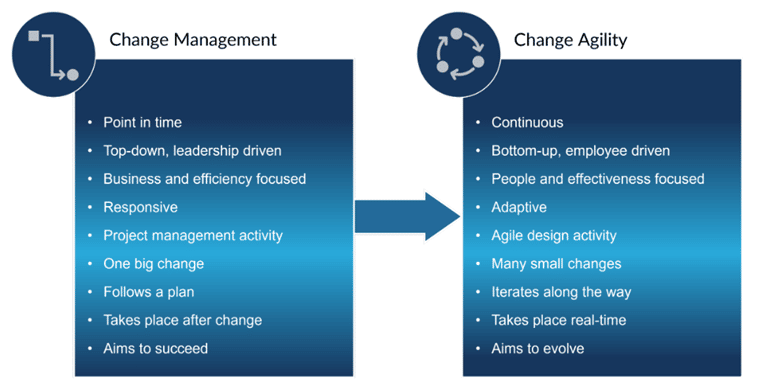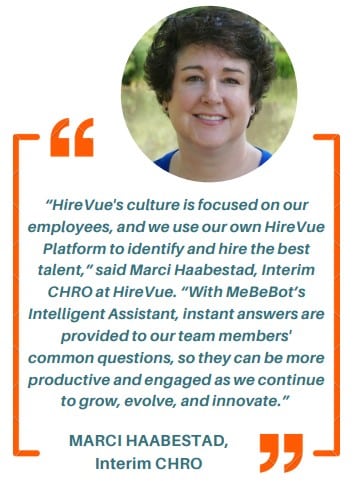It’s no surprise that if you do a quick research on “how people cope with change,” the search results will reveal that we (as humans) are not good at processing it. The uncertainty that comes with change throws our survival instincts into a flight, fight, or freeze response if we even smell the scent of change in the air. Building a culture that elicits change resiliency can be a challenge even for the most agile organizations.
Businesses in the past tried to wrestle change into a project-size component and control it into a solution that, once launched, would become a best practice operating procedure that lived on forever as a document on an Intranet site. This might have worked in post-industrial society, but in today’s world, this approach will only cause companies to become obsolete. The world we live in today is in flux, unexpected, and evolving rapidly.
R.I.P Change Management
Change management was one workstream of a project plan in the past. It was often limited to the communication, key stakeholder management, and preparedness activities tied to that project. These responsibilities often fell to the responsibility of the project manager. As a result, the success or failure of the acceptance and adoption of the project was solely on a single individual or team.
In today’s quickly evolving world, we don’t have the luxury of waiting on linear change management practices. Businesses need to adopt agility practices to anticipate their customer’s needs before someone else does. Plus, not to mention stay ahead of ever-changing federal, state, and city compliance to reduce risk. We must rethink change management and focus on building a culture of continuous improvement.
What is Agile?
Agile is an approach to project management that originated in software development. The agile framework refocused work away from individual contributors to teams. It scraped the linear waterfall approach and brought together employees with unique skills and capabilities to work together to deliver slices of value to the end consumer faster. It also puts the consumer at the center of the creation process. It created two-way communication channels to obtain feedback from the consumer in real-time to implement iterative solutions that continuously improve the product.
This agility skillset helped development teams adopt new practices that helped them pivot faster and become rapid responders. Imagine if we could harness that power within our workplaces; it is possible!
Agile is for Everyone
It is not enough for the engineering team to be agile. If the rest of the organization is on a different planning cycle, they will become a bottleneck and source of frustration creating misalignment and disconnection. I have seen companies freeze and fail. They get stuck in trying to make the familiar ways work instead of leaning into being uncomfortable and rethinking the structure of how they work. So, where do leaders start?

A more agile approach to change management builds change resiliency.
Bridging the Gap
Leaders need to understand that this work involves everyone coming together. It is not the sole owner of any department or individual, as it is a cultural shift that requires everyone in the organization to think and act differently. The leadership team needs to understand where they are today versus where they want to be in the future to provide directional focus strategically. Identifying the current and future state will help leaders understand the gap between where they are today and where they need to be.
This knowledge will help inform the type of bridge needed to be implemented to traverse the void. As leaders narrow in on the kind of bridge, they will start to see the skills, people, competencies, and tools needed to build the bridge one milestone step at a time and the barriers that need to be dismantled for employees within the company to come together to begin work.
Leverage Supportive Solutions
Often companies that begin this work get stuck, as their systems are outdated and don’t support the communication, feedback, skills learning, creativity, data, and remote/hybrid team collaboration needed for the adaptation of continuous improvement.
For example, Human Capital Management solutions are often built for a static set of parameters and rules that are hard to modify after launching. It takes time to submit configuration requests, and the system becomes more complex with each change, which often results in manual workarounds down the road. On top of that, these systems are not interactive and don’t capture employee feedback or usage data to help inform business leaders of ways to improve, leaving room for assumptions.

This results in tools that employees underutilize because they are no longer serving the purpose they intended, as the needs of the business may have shifted, and the HR team is unable to keep up. HR needs solutions like MeBeBot’s AI Intelligent Assistant, which provides real-time, consistent, and personalized answers to employee and manager questions within their primary communication channel (Microsoft Teams/Slack). Employees can give feedback and feel like their voice matters to improve the accuracy of the answers. HR can send tailored nudges and reminders directly to the intended audience at the moment it makes a difference. They can also collect quick data from their employees and managers through short surveys to inform better decisions.
Workplaces that integrate this level of digital transformation will find the level of engagement, alignment, and consistency of communication much-needed to empower the agility behaviors needed to fuel a continuous improvement culture.
MeBeBot’s AI Intelligent Assistant, recently selected as a “Brilliant Bot” in the Slack App Directory, seamlessly installs in Teams, Slack, or web portals to provide employees with instant automated answers to global HR, IT, and Ops FAQS. It also provides real-time usage Dashboards, Push Messaging, and custom Pulse Surveys, generating instant employee feedback on of-the-moment questions. MeBeBot’s “one-stop bot” is trusted by leading organizations to elevate the employee experience so work can be more meaningful and valuable.
Visit our website at https://mebebot.com
